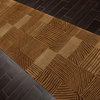
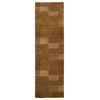
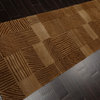
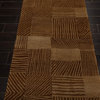
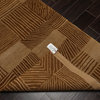
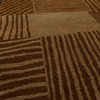
Item 1 of 6








Item 1 of 6


- Product Description
- Product Specifications
- Shipping and Returns
This is a beautiful Brown, Caramel, -- Select Color -- Color Hand Knotted, Tibetan Oriental Wool and Silk Rug. Story Behind the Art
For centuries Tibetans have used rugs for decorative and functional purposes, drawing upon geometric patterns, auspicious symbols, real and mythical animals, and natural imagery to create beautiful, colorful designs. But it was only after 1959 with the Chinese invasion of Tibet and the growth of Tibetan diaspora in Nepal and Tibet that Tibetan rug weaving underwent a crucial commercial revival. In the 1970s, Tibetan rugs rose to prominence and Nepalese artisans, drafted in to keep up with the rising demand, became the mainstay of the Tibetan rug weaving traditions. While either Turkish knot or the Persian knot (Senneh knot) is used to create the pile or depth of a rug in most of Asia, the Tibetan rug utilizes a slit-loop technique called the Tibetan knot. Here rugs are woven by wrapping a continues length of yarn over a rod laid across the warps stretched on the loom. When the rod has been wrapped for its entire length, a knife is slid along the rod, cutting the wrapped yarn into two rows of pile tufts. The resultant pile is a wonderful mix of depth, texture and richness. Traditional Tibetan rug motifs generally reflect the importance of Buddhist religion in Tibetan art and culture. Many design elements of Chinese origin like the phoenix, dragon, and lotus symbols alongside motifs from Chinese decorative tradition have also been assimilated in the rug repertoire of this region. In modern times, designs featured in Tibetan, Nepalese rugs (those woven by Tibetan refugees in Nepal) and Indo-Tibetans (woven in India) range from Westernized adaptations of traditional Tibetan motifs (such as branching floral designs and snow lions) to a large mixture of foreign and modern free-form patterns.
For centuries Tibetans have used rugs for decorative and functional purposes, drawing upon geometric patterns, auspicious symbols, real and mythical animals, and natural imagery to create beautiful, colorful designs. But it was only after 1959 with the Chinese invasion of Tibet and the growth of Tibetan diaspora in Nepal and Tibet that Tibetan rug weaving underwent a crucial commercial revival. In the 1970s, Tibetan rugs rose to prominence and Nepalese artisans, drafted in to keep up with the rising demand, became the mainstay of the Tibetan rug weaving traditions. While either Turkish knot or the Persian knot (Senneh knot) is used to create the pile or depth of a rug in most of Asia, the Tibetan rug utilizes a slit-loop technique called the Tibetan knot. Here rugs are woven by wrapping a continues length of yarn over a rod laid across the warps stretched on the loom. When the rod has been wrapped for its entire length, a knife is slid along the rod, cutting the wrapped yarn into two rows of pile tufts. The resultant pile is a wonderful mix of depth, texture and richness. Traditional Tibetan rug motifs generally reflect the importance of Buddhist religion in Tibetan art and culture. Many design elements of Chinese origin like the phoenix, dragon, and lotus symbols alongside motifs from Chinese decorative tradition have also been assimilated in the rug repertoire of this region. In modern times, designs featured in Tibetan, Nepalese rugs (those woven by Tibetan refugees in Nepal) and Indo-Tibetans (woven in India) range from Westernized adaptations of traditional Tibetan motifs (such as branching floral designs and snow lions) to a large mixture of foreign and modern free-form patterns.
3'x10' Hand Knotted Wool and Silk Lapchi Patchwork Area Rug, Brown
$519
Only 1 Left - Order soon!
Free Shipping
Est. Delivery: May. 3 - May. 6 (to )
Qty: 1
This is a beautiful Brown, Caramel, -- Select Color -- Color Hand Knotted, Tibetan Oriental Wool and Silk Rug. Story Behind the Art
For centuries Tibetans have used rugs for decorative and functional purposes, drawing upon geometric patterns, auspicious symbols, real and mythical animals, and natural imagery to create beautiful, colorful designs. But it was only after 1959 with the Chinese invasion of Tibet and the growth of Tibetan diaspora in Nepal and Tibet that Tibetan rug weaving underwent a crucial commercial revival. In the 1970s, Tibetan rugs rose to prominence and Nepalese artisans, drafted in to keep up with the rising demand, became the mainstay of the Tibetan rug weaving traditions. While either Turkish knot or the Persian knot (Senneh knot) is used to create the pile or depth of a rug in most of Asia, the Tibetan rug utilizes a slit-loop technique called the Tibetan knot. Here rugs are woven by wrapping a continues length of yarn over a rod laid across the warps stretched on the loom. When the rod has been wrapped for its entire length, a knife is slid along the rod, cutting the wrapped yarn into two rows of pile tufts. The resultant pile is a wonderful mix of depth, texture and richness. Traditional Tibetan rug motifs generally reflect the importance of Buddhist religion in Tibetan art and culture. Many design elements of Chinese origin like the phoenix, dragon, and lotus symbols alongside motifs from Chinese decorative tradition have also been assimilated in the rug repertoire of this region. In modern times, designs featured in Tibetan, Nepalese rugs (those woven by Tibetan refugees in Nepal) and Indo-Tibetans (woven in India) range from Westernized adaptations of traditional Tibetan motifs (such as branching floral designs and snow lions) to a large mixture of foreign and modern free-form patterns.
For centuries Tibetans have used rugs for decorative and functional purposes, drawing upon geometric patterns, auspicious symbols, real and mythical animals, and natural imagery to create beautiful, colorful designs. But it was only after 1959 with the Chinese invasion of Tibet and the growth of Tibetan diaspora in Nepal and Tibet that Tibetan rug weaving underwent a crucial commercial revival. In the 1970s, Tibetan rugs rose to prominence and Nepalese artisans, drafted in to keep up with the rising demand, became the mainstay of the Tibetan rug weaving traditions. While either Turkish knot or the Persian knot (Senneh knot) is used to create the pile or depth of a rug in most of Asia, the Tibetan rug utilizes a slit-loop technique called the Tibetan knot. Here rugs are woven by wrapping a continues length of yarn over a rod laid across the warps stretched on the loom. When the rod has been wrapped for its entire length, a knife is slid along the rod, cutting the wrapped yarn into two rows of pile tufts. The resultant pile is a wonderful mix of depth, texture and richness. Traditional Tibetan rug motifs generally reflect the importance of Buddhist religion in Tibetan art and culture. Many design elements of Chinese origin like the phoenix, dragon, and lotus symbols alongside motifs from Chinese decorative tradition have also been assimilated in the rug repertoire of this region. In modern times, designs featured in Tibetan, Nepalese rugs (those woven by Tibetan refugees in Nepal) and Indo-Tibetans (woven in India) range from Westernized adaptations of traditional Tibetan motifs (such as branching floral designs and snow lions) to a large mixture of foreign and modern free-form patterns.
- Model # (MPN)
- HOU16764
- Product ID
- 187939880
- Manufactured By
- Oriental Rug Of Houston
- Sold By
- Houzz
- Size/Weight
- W 36" / D 0.5" / H 120" / 20 lb.
- Color
- Brown Caramel
- Materials
- Wool and Silk
- Assembly Required
- No
- Category
- Hall And Stair Runners
- Style
- Contemporary
- Collection
- Runner
- Commercial-grade
- Yes
Sold by Houzz- Free shipping!
Ready to ship to the contiguous U.S. in 1-3 days
This product does not ship to Canada
Note: Free shipping is not available to AK, HI, PR or Canada. Some exclusions apply.
Houzz offers a 30-day standard return policy for most items. We also accept returns on damaged large or oversized items that ship via freight, as long as you report the damage within 5 days of delivery. View our full return policy.
- Product Description
- Product Specifications
- Shipping and Returns
This is a beautiful Brown, Caramel, -- Select Color -- Color Hand Knotted, Tibetan Oriental Wool and Silk Rug. Story Behind the Art
For centuries Tibetans have used rugs for decorative and functional purposes, drawing upon geometric patterns, auspicious symbols, real and mythical animals, and natural imagery to create beautiful, colorful designs. But it was only after 1959 with the Chinese invasion of Tibet and the growth of Tibetan diaspora in Nepal and Tibet that Tibetan rug weaving underwent a crucial commercial revival. In the 1970s, Tibetan rugs rose to prominence and Nepalese artisans, drafted in to keep up with the rising demand, became the mainstay of the Tibetan rug weaving traditions. While either Turkish knot or the Persian knot (Senneh knot) is used to create the pile or depth of a rug in most of Asia, the Tibetan rug utilizes a slit-loop technique called the Tibetan knot. Here rugs are woven by wrapping a continues length of yarn over a rod laid across the warps stretched on the loom. When the rod has been wrapped for its entire length, a knife is slid along the rod, cutting the wrapped yarn into two rows of pile tufts. The resultant pile is a wonderful mix of depth, texture and richness. Traditional Tibetan rug motifs generally reflect the importance of Buddhist religion in Tibetan art and culture. Many design elements of Chinese origin like the phoenix, dragon, and lotus symbols alongside motifs from Chinese decorative tradition have also been assimilated in the rug repertoire of this region. In modern times, designs featured in Tibetan, Nepalese rugs (those woven by Tibetan refugees in Nepal) and Indo-Tibetans (woven in India) range from Westernized adaptations of traditional Tibetan motifs (such as branching floral designs and snow lions) to a large mixture of foreign and modern free-form patterns.
For centuries Tibetans have used rugs for decorative and functional purposes, drawing upon geometric patterns, auspicious symbols, real and mythical animals, and natural imagery to create beautiful, colorful designs. But it was only after 1959 with the Chinese invasion of Tibet and the growth of Tibetan diaspora in Nepal and Tibet that Tibetan rug weaving underwent a crucial commercial revival. In the 1970s, Tibetan rugs rose to prominence and Nepalese artisans, drafted in to keep up with the rising demand, became the mainstay of the Tibetan rug weaving traditions. While either Turkish knot or the Persian knot (Senneh knot) is used to create the pile or depth of a rug in most of Asia, the Tibetan rug utilizes a slit-loop technique called the Tibetan knot. Here rugs are woven by wrapping a continues length of yarn over a rod laid across the warps stretched on the loom. When the rod has been wrapped for its entire length, a knife is slid along the rod, cutting the wrapped yarn into two rows of pile tufts. The resultant pile is a wonderful mix of depth, texture and richness. Traditional Tibetan rug motifs generally reflect the importance of Buddhist religion in Tibetan art and culture. Many design elements of Chinese origin like the phoenix, dragon, and lotus symbols alongside motifs from Chinese decorative tradition have also been assimilated in the rug repertoire of this region. In modern times, designs featured in Tibetan, Nepalese rugs (those woven by Tibetan refugees in Nepal) and Indo-Tibetans (woven in India) range from Westernized adaptations of traditional Tibetan motifs (such as branching floral designs and snow lions) to a large mixture of foreign and modern free-form patterns.
At Houzz we want you to shop for Oriental Rug Of Houston 3'x10' Hand Knotted Wool and Silk Lapchi Patchwork Area Rug, Brown part # HOU16764 with confidence. You can read real customer reviews for this or any other product and even ask questions and get answers from us or straight from the brand. When you buy Oriental Rug Of Houston 3'x10' Hand Knotted Wool and Silk Lapchi Patchwork Area Rug, Brown or any product product online from us, you become part of the Houzz family and can expect exceptional customer service every step of the way. If you have questions about Oriental Rug Of Houston part # HOU16764 or any other product for sale, our customer service team is eager to help.







